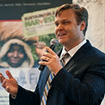M-Prize Winner
This story is one of ten winning entries in the Long-Term Capitalism Challenge, the third and final leg of the Harvard Business Review / McKinsey M Prize for Management Innovation.
Story:
The MONDRAGON Cooperative Experience: Humanity at Work
Broad employee ownership of enterprise is MONDRAGON’s key to a long-term capitalism. It is the centerpiece of a values-based business model captured in our logo, Humanity at Work. We put it into practice through an innovative, multi-level network of cooperative enterprises, based on a bottom-up corporate architecture, in effect, an inverted conglomerate.
Background:
Headquartered in the Basque Country of northern Spain, MONDRAGON is often considered the most successful example of employee-owned, cooperative, enterprise in the world. What started in 1956 with a handful of workers making simple paraffin cookers and heaters, now consists of over 82,000 people in an integrated group of some 258 cooperatively-owned businesses, subsidiaries, and affiliated organisations, with total sales in 2011 of 14 € billion.

MONDRAGON is essentially a network of 109 cooperatives, which own, among them, 125 subsidiaries, and integrate other 24 support entities - that give them crucial competitive and social advantages - reaching a total of 258 organisations. They are all linked through a structured, but flexible umbrella – the MONDRAGON Corporation – they are, in fact, full-fledged members of this Corporation; its governance structures are accountable to them. For strategic purposes, the member firms and their affiliates are distributed among the three major areas shown on the chart below. The Finance Area embraces three specific activities: banking, social security and Insurance. The Retail Area is a network of supermarkets, cash & carries and other consumer goods chains with more than 2600 outlets. Most MONDRAGON coops are in Industry Area, which is itself divided into 12 different divisions as shown in the Figure below. Over the years, the MONDRAGON companies also created a series of cooperative institutions for R&D, consulting and education and training (including a university with 3,610 students). These are pictured at the bottom of the chart and form a fourth major area of the Corporation, “Knowledge”.

The figure above summarizes our business activity and management structure. Two governance bodies oversee their activity, the Co-operative Congress and the Standing Committee, and we describe these in a later section of our story.
Historical background
The founding leaders of MONDRAGON were five young men, inspired and guided by a local priest, Fr. José María Arizmendiarrieta. Sent to the town of Mondragon in 1941 as a parish priest, amidst the poverty and repression of the Franco dictatorship in the immediate post-Civil War era, Arizmendiarrieta saw education as one of his most fundamental tasks. He started a tiny vocational-technical school in 1943, which grew gradually but steadily into a sizeable educational undertaking. He developed all manner of other educational initiatives, formal and informal, for children and adults, on a wide variety of topics; technical, religious, cultural, and recreational. He also rallied the local people and, using informal participatory methods, spurred them to undertake community-building tasks of all kinds. A core group of people, mostly youth, became followers of Arizmendiarrieta. They got involved in many of his educational activities and became imbued with his philosophical point of view.
Arizmendiarrieta had read widely in social science and political philosophy and was a forceful proponent of Catholic Social Doctrine. This Doctrine is critical of conventional capitalist economics and business practice, calling for less hierarchy and a greater emphasis on cooperation and human development. As the years passed, Fr. Arizmendiarrieta became increasingly interested in taking real steps toward moving these ideas into the business arena. His goals were both ethical-religious as well as concrete and pragmatic. He hoped to promote individuals’ moral character as well as social justice through the creation of a new kind of work place, one that encouraged hard work, cooperation, shared rewards, and individual responsibility. At the same time, he sought to generate employment and income in a region that had been impoverished by war, dictatorship and neglect. After consulting with legal experts, he eventually decided that the “worker cooperative” provided the best legal structure for pursuing these goals.
The experience of several of the young men who had been among his closest followers in the 1940s and 1950s is what finally provoked this search for a legal form for a new kind of business. They had graduated from the vocational school he had established and had started to work in the Unión Cerrajera, a large company that had dominated the Mondragon economy for over a generation. After seeking, with Arizmendiarrieta, to introduce humanist reforms in the company and failing, they decided, with his encouragement, to start their own business, and in 1955-56, they founded “ULGOR”, as an employee-owned, cooperative, based on Arizmendiarrieta’s legal research and consultations.
Other followers of the priest, as well as acquaintances of the founders and others, began to set up new cooperative enterprises in the area, and these soon became loosely affiliated with each other. The MONDRAGON group then grew steadily through the 1960s and much of the 1970s. By 1970, there were 8,570 worker-members in 54 cooperative firms. Ten years later the numbers had grown to 18,733 worker-members and 96 cooperatives.
Again, inspired and at times led at first by Arizmendiarrieta, starting in the late 1950s, we also began to establish the network organisation mentioned earlier, a network which has been vital to our ultimate success. We started with a cooperative bank in 1959, then added a social security and insurance cooperative, next, a supermarket chain, and technology R&D cooperatives, regional subgroups and, all along, several dozen other employee-owned, manufacturing cooperatives producing a wide range of products; machine tools, automotive components, industrial equipment and others. We have also worked on the network arrangement over the decades, constantly trying to adapt its structure and functions to new circumstances. We summarize these later in Part 3 “Innovations & Timeline”.
Broad-based, “networked” employee-ownership in MONDRAGON was triggered by four things back in the 1940s: (1) scarce opportunities for education; (2) large-scale unemployment and poverty; (3) socioeconomic inequality; and, (4) a commitment to integrate humanist values into business.
The town of Mondragón in 1940s was poor. There was virtually no schooling available for children over 12 years old. A tiny minority monopolized the area’s wealth and power. MONDRAGON’s early leaders sought to overcome these challenges by rallying local people, not to protest and resist, but rather to build their own alternative, one grounded in human-centered values, an alternative that provided educational opportunities for all, that created employment and wealth in which all could take part, and for which all – each and every individual – would recognize his her own responsibilities. This certainly meant building their own schools, which they did, but it also required taking these values and fully integrating them into the economy, into the very structure, policy and practice of the business enterprise. These values could not be left at the factory gate. As we have seen, their main approach to this was broad-based, employee ownership of business – everyone a co-owner, everyone with ownership rights and ownership responsibilities. This was the focus of the early leaders’ strategy and remains at the heart of our approach up to the present day.
The network idea was triggered by the first generation of leaders taking the cooperative idea and applying it not only inside the business, but among businesses as well. They felt that their dramatically new approach to enterprise was probably not going to be well-understood by conventional companies in finance, insurance, research, etc, so they decided to create their own. They also believed it would be difficult for what were then small firms to prosper on their own over time, that they would not only need these key services, but also that if they joined forces, they would find the support they needed during downturns as well as synergies and opportunities during upturns. In summary, the network was a far-sighted innovation that has been crucially important both to our business success and to our ability to promote democratic, humanist values in our business practice.
Our key innovation is broad-based employee ownership that has been used as the glue for the flexible network of companies we have talked about. The timeline identifies milestones that relate to this theme: spreading employee ownership to ever new organisations and sectors, and the role they play in the network.
- 1943 – Vocational school founded by Arizmendiarrieta. Key network element:EDUCATION
- 1956 – Employee-owned, manufacturing cooperative, Ulgor (today Fagor Home Appliances). Key network element:ENTERPRISE … (followed by 80 more employee-owned manufacturing cooperatives)
- 1959 – Cooperative Bank, Caja Laboural. Combines employee and firm-user ownership. Key network element:FINANCE
- 1967 – Pension and Health Insurance Cooperative Lagun Aro. Key network element: HEALTH CARE & SOCIAL SECURITY. The Spanish social security system of the 1950s and 60s only offered health and pension coverage for regular employees, not for cooperative members which it defined as self-employed. To solve this problem, which both created uncertainty for existing cooperative members and limited the co-ops’ ability to attract new workers, MONDRAGON created its own system, Lagun Aro.
- 1969 – Retail Cooperative Eroski. Combines employee and consumer ownership in a new sector. Key network element: RETAIL
- 1974 – R&D Cooperative Ikerlan. Combines employee and firm-user ownership in a new sector. Key network element: TECHNOLOGY R&D
- 1984 – Training Organisation Otalora. Key network element: MANAGEMENT & COOPERATIVE TRAINING
- 1991 – Mondragon Cooperative Corporation (MCC). Key network element: JOINT STRATEGIC AND MARKET ORIENTATION
- 1996 – First Corporate Management Model. Key network element: MANAGEMENT EXCELLENCE
- 1998 – Mondragon University. Key network element: HIGHER EDUCATION
- 2004 – ”The Meaning of MONDRAGON Experience” Consultation Initiative. Key network element: CO-OWNERSHIP VALUES REVITALIZATION: For nearly two years, more than 2000 people from the different cooperatives attended a reflection on the level of actual implementation of the principles and cooperative values. The conclusion was a paper approved by Congress that incorporated an action plan in the areas of education, empowerment and social transformation
- 2007 – Co-ownership-based Management Model. Key network element: RENEWED CO-OWNERSHIP VALUES INTO PRACTICE Starting from a previous model based on the concepts of total quality, we developed our own Management Model to provide guidelines to how implement the cooperative principles in everyday business management. Our corporate management model is further discussed below.
- 2008 – MONDRAGON Corporation: Humanity at work. Key network element: COHERENT, CONSISTENT CORPORATE IMAGE. Changing the corporate image of MONDRAGON to try to transmit the essence of our experience: Humanity at work
- 2011 – New Vision and Policy Statement. Key network element: SUSTAINABILITY IN A GLOBAL CONTEXT. The Vision establish: “We shall transform our business fabric by driving today’s deliverables to be of a greater worth and by advancing new operations in high value added sectors, based on the strengths of Inter-cooperation, Innovation-Promotion-Knowledge and the opportunities of Globalisation, adapting and reinforcing our corporate identity through our own Management Model”. Currently, all cooperatives are developing strategic thinking processes to define the precise way in which this vision will develop in the years 2013-2016.
MONDRAGON’s Corporate Management Model
Our Corporate Management Model (CMM) provides the Corporation’s Cooperatives with guidelines for their everyday business management in a manner so that they are both efficient and consistent with our corporate culture and ownership values.
Our CMM has several interlocking elements, summarized below:

In the center of the model, and as a point of departure, there are the Basic Cooperative Principles, which provide People in Cooperation with procedural guidelines for implementing the Cooperative’s values. These are the people who build a Joint Project and embrace Participative Organisation in order to undertake it. Yet this project is undertaken in a context of market and product, with customers, suppliers, partners, etc., within the same business environment as competitors. Although the actual cooperative format itself provides us with clear advantages in the application of today’s most advanced management concepts, these have to be implemented in order to become an Excellent Company. Operating results are the main focal point of control regarding the efficiency of the management model—there are no excellent companies with poor results. It is therefore essential to construct and monitor a comprehensive performance dashboard, selecting relevant indicators to verify whether we are obtaining good Socio-entrepreneurial Results.
Detailed descriptions of each of these elements can be found in “Helpful Materials” section at the end of this story. What follows is a short summary of the first element of the Management Model—the Basic Cooperative Principles.
These 10 principles are further summarized in the figure below. The core is occupied by education as the basic principle that nourishes all the others, together with the sovereignty of labour, that is, broad employee ownership. These are shielded by the five other principles internal to each individual cooperative company: the instrumental and subordinated nature of capital, democratic organisation, open admission, participation in management, and wage solidarity. The outer ring features the three principles that are related to cooperatives’ external projection: inter-cooperation, social transformation, and universality.
MONDRAGON’s Basic Cooperative Principles

These principles have a direct impact in how MONDRAGON is managed—for instance:
- The “education” principle shapes the heavy investment MONDRAGON makes to improve its human capital, as well as in the diffusion of cooperative values across the network;
- The “sovereignty of labour” principle is about broad employee ownership. People who work in an organisation, who contribute their labour, should share in ownership rights regarding that organisation, rights in its governance and in the distribution of the wealth the organisation’s members create together. As a result, capital, here, is subordinate to labour; it is a tool used by the members of an organisation to achieve the goals they set for themselves. Ownership rights, though, also mean ownership responsibilities, in this case, to recognize that, although capital is subordinate to labour, it is an indispensable instrument for business development,
- The “democratic organisation” principle means that leaders are accountable to the members. It means that governance bodies in MONDRAGON are democratic, based on the principle of one-member, one-vote (detailed further below). It also implies open admission, that membership is open to any person who accepts these basic principles without discrimination of any kind.
- The “participation in management” principle fosters the progressive development of self- management: the flattening of hierarchy, the creation of multiple, flexible structures for organizing worker involvement in decision making and the training of staff at different levels in order to help make participation widespread and effective.
- The principle of “wage solidarity” drives the low differential we have between the lowest and highest paid—roughly 1:6 at the level of the individual cooperative.
Our challenge has been to “keep our balance”, so to speak. This actually turns out to mean we try to maintain several key balances:
THE BUSINESS and SOCIAL BALANCE: Competitiveness is indispensable, but it must be balanced by focusing on job creation, strengthening participation, sharing wealth and respecting the environment. In the day-to-day intensity of running competitive businesses in global markets, it is not difficult lose sight of social concerns, to hope if we do our job well that these things will take care of themselves. We have become convinced, though, that they will not take care of themselves. Just as innovation and implementation don’t happen by themselves on the business side, they need to be treated consciously and strategically on the social side. We have created network-wide governance bodies and policies whose job it is to remind us continuously of our social roots and priorities, and to help us turn them into practical realities (these are described in detail below).
THE CO-OWNERS and WORKERS BALANCE: Co-owners have ownership rights in firm governance and distributing profit. Consider governance first. Worker-owners have rights to leadership accountability through democratic governance bodies, to participation in decision making about company rules, policy and strategy. They exercise these rights in the general assembly of their cooperative, the firm’s highest authority. There workers also elect their board of directors, called the governing council, which in turn appoints the chief executive and must approve his or her choices for the co-op’s senior managers. Co-owners also have a right to a share of annual profits, which are distributed in proportion to pay.
Worker-owners have definitive ownership rights, but they also have workers’ responsibilities, that is, responsibilities to accept different roles in the enterprise, respect expertise and “play by the rules”. The “rules” (business by-laws, policies and practices) should be frequently reviewed, widely debated and regularly “innovated”, but there is a time for debate and a time putting the results of our debate to work.
The two roles of OWNER and WORKER are somewhat in tension, but they are also complementary, two sides of the same coin. When co-owners act as workers, accepting the expertise and ”local authority” of others, they know that they have ownership rights that they can and should exercise to assure accountability and fairness, and this knowledge helps keep things in balance. The rights and responsibilities balance helps us promote participation in operational decisions and we put a great deal of emphasis on practices that encourage participation and self-management. Information transparency is one key to this arrangement (in fact any co-op member can ask for his company’s financial statements at any time). All co-owners have two meetings a month – one with their coordinator and one with their Social Council rep – in which key financial, business and social information is discussed, including information from the firm, the division and MONDRAGON as a whole. Opinion and perspectives are transmitted in both directions and through these different channels, one on the management side and one on the governance side.. Other key approaches to promoting participation include: (1) reducing levels in the hierarchy – making organizations flatter; and (2) Promoting self-managing teams in all aspects of the business that have significant control over goal-setting and measurement, quality, customer service, teams whose mangers’ role is mainly to coordinate, provide them with resources and resolve conflicts. These are spelled out in more detail in the attached .pdf describing our management model.
Many of these practices are not uncommon in conventional companies. A multitude of investor-owned business of all sizes and shapes see the human and business wisdom of participatory decision making and self management. What helps us stand out is the combination of employee ownership and participation. They naturally complement each other. If fact, employee ownership without employee participation is a contradiction, plain and simple, and most employees sense this right away. Part of the very meaning of ownership is the capacity to make decisions about what one owns. We say this helps us “stand out”, but only to a degree. We are far from alone in this regard. There are numerous examples of successful companies with broad employee ownership who fully understand the necessity of combining ownership with participation and who do this in dozens of creative ways.
Consider a couple concrete examples of participation and self-management from MONDRAGON co-ops in two quite different manufacturing contexts:
- One would be self-managed project teams in Soraluce, world leader in milling machine tool manufacturing. When an order arrives at Soraluce, a cross-sectional project team is formed from manufacturing and assembly workers, engineers and sales staff. This team has full P&L responsibility for that particular machine tool from the arrival of the order and the creation of the team through onsite installation by Soraluce staff wherever the client might be in the world. Since the process is complex and can last from 6 – 18 months, the intensity of each team member’s work on the team varies over time, which allows them to also participate in other project teams. The team meets continuously throughout the life of the project to evaluate its P&L and to make decisions on improving any aspect of the product or process.
- In many other cooperatives with ongoing manufacturing processes, as in Fagor Home Appliances, for example, production is organized into teams in what we call “mini-companies”. Each mini-company is fully autonomous in a particular area of the plant that is dedicated to a specific part of the production process. Its responsibilities include: housekeeping, equipment maintenance, product quality, on-time delivery and productivity (volume and cost). Each group of 15 - 20 employee-owners has daily and weekly meetings to follow its progress in terms of performance indicators it sets for itself and to solve problems as they arise. The traditional “supervisor” role disappears; each team selects from among its most qualified members one person to serve as its coordinator, a role that rotates periodically. The coordinator and his or her team members establish the team’s own training needs in order to ensure that, over time, all team members are qualified to work at any post in the mini-company.
THE COLLECTIVE and THE INDIVIDUAL BALANCE: We need to focus on “the collective interest.” The enterprise belongs to its founders and its current generation, but it must survive these so it can also belong to future generations. To address this collective side, our policy is to take nearly half our after-tax profits and re-invest them in the business; they are not distributed. Most of the other half is “allocated” to individuals, but we don’t take out in cash. Our policy is to leave it invested in the enterprise until we retire. The collective interest, though, must be balanced by addressing individuals’ interests. Individuals earn competitive salaries (though they cut them when they need to); they leave their annually allocated profit share in the company, but they are paid interest on their balance each year and, when retirement arrives, it belongs to them. Retirement income does not depend on our accumulated profit shares. The company and the individual both contribute monthly to our pension and insurance system, Lagun Aro.
THE SMALL and THE LARGE BALANCE: To put our values into practice, that is, for co-ownership to be real, for accountability to be meaningful, for real cooperation and a sense of community to flourish, to sense that “we are all in this together”, we need to be small, to work on a human scale. At the same time, to gain economies of scale, to accumulate serious resources for growth, research and innovation, to compete in the wide world, we need to be big. To balance “the need for small” and “the need for big”, we have developed the network, what MONDRAGON calls Inter-cooperation. Day-to-day operations are in small organisations or business units, with decentralized decision making and distributed leadership. But when many of “the small” join together, pool some of their time and resources, they can make “the big”. This is the MONDRAGON Corporation. Two hundred and fifty eight organisations join together in Areas and Divisions by product/market. The companies in each Area or Division coordinate their activities, share a portion of profits, do joint strategic planning and are constantly looking for synergies. The Areas and Divisions come together to make the Corporation.
Every business operates in a specific product/market context. The Corporation ensures that there is no competition among the network businesses and, even more importantly, fosters collaboration among them to create new businesses that take advantage of new market opportunities. Usually these new businesses are headed up by entrepreneurs that come from existing cooperatives.
One example of cross-unit collaboration comes from MONDRAGON’S Automotive Division: the “Sustainable Mobility” project. The sustainable mobility project initially involved 35 engineers drawn from several Automotive cooperatives, who worked 18 months to produce an electric car prototype, and make progress on several other “green” transportation initiatives. Currently, 130 MONDRAGON researchers and engineers from various cooperatives are working on the development of products linked to the electric car. Plans call for €15m in investment to develop these programs in the short term.
There is no set maximum size for each business. Size depends on the industry and our resources and capabilities. The dynamics of MONDRAGON’s intrapreneurship generally lead us to promote growth in many small to medium-sized businesses rather than in a few large firms. MONDRAGON’s business unit structure is “cellular” and dynamic—when new opportunities arise, new cooperative ventures or business units are formed to take advantage of these. In some cases, these new ventures might be jointly owned by existing cooperatives and/or conventional firms, who would then act as joint venture partners.
As an example, MONDRAGON recently founded a new company, Smart Health Services (SHS), for managing integrated purchasing and supply logistics for health centres. This is a new type of business, combining a variety of health centre management services, and its aim is to become a driver for integrating the capacities of different organizations from different parts of the Corporation. As a result, SHS is a joint-venture promoted by the MONDRAGON Health cooperative platform, which holds 51% of its shares and another Mondragon co-op, LKS Consultancy, whose capital stake is 9%. MONDRAGON firms, then, hold 60% of the capital and SHS forms part of the MONDRAGON Corporation. However, another company, Kudea, not a MONDRAGON firm, is also a stakeholder, with 40% of SHS’s capital. Kudea is a company specialising in the management of purchasing and general contracting processes, and has substantial experience in the private health care sector..
Another example of inter-cooperation is an organisation we created to achieve volume purchasing advantages. Several years ago, 16 MONDRAGON co-ops co-created this new service, and housed it in an organisation called Ategi S. Coop. Ategi’s job is to put together the purchasing needs for utilities and other products/services (computers, phone/internet, etc.) of as many MONDRAGON co-ops as possible, select and negotiate with suppliers and “deliver” the finished purchasing agreement to the co-op member. Any MONDRAGON company can join Ategi by making a membership investment and it may use Ategi for purchasing any one or combination of products/services. Sixty co-ops are now members. Ategi charges these co-ops a fee for its services, but it is a non-profit organisation. It projects its expenses and then establishes its fee structure in order to cover those expenses, not to maximize profit.
THE AUTONOMY and POWER DELEGATION BALANCE: Another balancing act is the one between the autonomy of the individual companies and delegation of power to coordinating bodies. It’s related to the SMALL – LARGE BALANCE. Intimate knowledge of operations and local issues is clearly in the individual cooperative companies. Key concerns that relate most to those operations and to the people most involved in them need to be addressed at the local level, the level of the individual company. Local autonomy on these issues is important to make co-ownership real, to fortify co-ownership’s implications for work on a human scale, understanding one’s business, genuine accountability, personal relationships and a sense of community. But, as we talked about before, it’s also important for us to be large, to create central bodies with significant authority that are able to marshal substantial resources and make key decisions. So we created the network, that is, the Corporation, with its Areas and Divisions and their General Council.
Mondragon’s management structure is that of an “inverted conglomerate”, a traditional conglomerate turned on its head. The operational decisions and ultimate authority lie at the “bottom” with the individual cooperative companies and their employee-owner-members. Here are a few defining features of our leadership and governance structure, starting at the level of the individual cooperative and moving “up”, in a sense, to the network organization.
Basic Internal Structure of a MONDRAGON Co-operative:
The highest governance authority in a Mondragon cooperative company is the General Assembly of worker-members. It meets at least once a year, votes on major issues and elects an internal board of directors called the Governing Council based on the principle of one member-one vote. The Council then elects a President from among its members. The Governing Council and its President represent the Assembly between its meetings, oversee the execution of Assembly decisions, generally monitor the performance of the company and its senior management, and debate and decide issues of strategic importance. The Council appoints, and may remove, the Chief Executive Officer (CEO) and must approve his or her choices for senior managers or unit directors. The CEO and his/her senior management team, together, form the Management Council, which is the body responsible for the day-to-day management of the firm. Worker-members also elect an Audit Committee to monitor the firm’s finances, and work-area representatives to a company-wide Social Council whose role is to facilitate communication among the worker-members, management and the Governing Council, and generally represent frontline workers’ perspective in company decision making

Divisional bodies and roles are similar to the individual Cooperative
At Divisional level there is a Governing Council elected by the representatives of the Governing Councils of its member Cooperatives. The Divisional Governing Council members then elect a President from among their number. The Divisional Governing Council appoints the Director of the Division, who becomes a Vice President of MONDRAGON for that division. He or she coordinates the division with the CEOs of the other co-ops in the division and together they make up the Divisional Management Council. It is important to emphasize, though, that authority resides in the individual co-ops; the divisional structure is a coordinating body, not an executive one in the conventional sense. The Division cannot impose decisions on its company members. The Division Director / VP, similarly, is a coordinating-negotiating-facilitating role, again, not an executive role as might be found in an ordinary multinational. To be clear, the people who occupy these positions are senior people, with proven track records, but their track records are both as business managers and as cooperative leaders, that is, as communicators-facilitators. They have substantial, call it, moral authority, as well as technical authority, with the senior managers and members from the co-ops in their divisions. One key coordinating role of the division director, among others, involves strategic orientation. Division leaders take broad strategic guidelines developed by MONDRAGON’s network bodies (see below) and work with their divisional management council colleagues to make the strategic guidelines concrete and meaningful for the co-ops in their particular division. Then the individual co-op firms in the division and their business units make the strategic guidelines even more concrete and specific to their individual situations. The business unit and co-operatives’ strategic plans are then sent to the division for review and comment, and to have people with the broad divisional view look for synergies and other joint opportunities. But again, the Division Directors cannot make executive decisions. If they have opinions, they have to work as facilitators and communicators – as leaders in the human as opposed to hierarchical sense of the word – and try to persuade division co-op members to see their point of view.
This arrangement is not perfect. Since the authority rests in the individual companies, some business opportunities at the divisional level are lost. The Division Director cannot order the co-ops in his or her Division to get together and take advantage of thus and such an opportunity; hence, inevitably, some are missed due to disagreements among individual co-ops and the like. On the other hand, the kind of negotiated divisional decisions made tend to be based on much more full agreement and commitment than imposed decisions would be, and hence they are implemented more quickly and more fully. The system has advantages and disadvantages, but we feel strongly that, over the long-term – which is what this event is all about – the advantages of decentralisation and “bottom-up” authority structures decidedly outweigh the disadvantages of occasional missed opportunities, particularly in a network based on broad employee-ownership.
We should also mention profit-pooling among co-ops at the divisional level. Fifteen to forty percent of pre-tax profits are pooled among co-ops in a division, and then re-distributed based on need, that is, mainly to help strengthen the co-ops doing least well. The actual percentage pooled in each division is determined by the division’s Governing Council and it depends on how integrated the divisions companies are, integrated, that is, both in terms of tangibles such as shared products/markets, but also in terms of intangibles such familiarity and trust that might have arisen over years of collaboration. The less integrated the division is, the lower the percentage of profit pooling tends to be, but the trend is for divisions to look for synergies and promote integration and thus to gradually raise the level of profit pooling.
Many ask if the profit pooling system promotes free-riding. The short answer is “almost never.” There have been co-ops whose economic performance has been weak over somewhat prolonged periods and who consistently received support from their divisions, but we think that their protracted problems were not at all related to free-riding. In fact, the divisional structure requires that a given co-op’s senior manager and its senior governance official (Governing Council President) meet regularly with her or his divisional counterparts. At these meetings, everyone reports on his or her company’s progress with respect to annual and strategic objectives, etc, asks for advice and comment, requests assistance, financial or otherwise, if necessary and the like. Under these arrangements, the pressure on managers whose co-ops are doing poorly to take measures to improve their performance is quite intense. In fact, in order to receive help from its division, a co-op must defend and document the various measures it is taking to address its problems, including financial sacrifices approved by employee-owners such as pay cuts or the forgoing of interest (dividend-like) payments owners’ capital stakes, or others.
In addition, co-ops know that decentralised authority is a double-edged sword. It means you, Co-op Company X, have the autonomy you want, but it also means you, Co-op Company X have the responsibility to resolve your own problems. Everyone recognizes that assisting companies in trouble is by far preferable to allowing problems to worsen, but everyone also recognizes where the main responsibility for resolving problems lies – in the same place where autonomy lies, that is, in the individual co-operative firm.
We should also point out that almost all co-ops recognize that what goes around comes around. In other words, almost every co-op in MONDRAGON has had more or less serious problems at one point or another and has been assisted, even saved, by its fellow co-ops. Co-op “X” may be frustrated at the moment with the seemingly unresolved problems and ongoing need for assistance of Co-op “Y”, but Co-op “X” knows that its turn to ask for help and patience will almost certainly come up again sooner or later and it will be Co-op “Y’s” turn to be patient.
In addition, MONDRAGON co-ops also contribute through investment and donations to central funding mechanisms, with roughly 10% of their profits. One of these is essentially a revolving venture capital fund. By pooling funds from many co-ops over multiple years, MONDRAGON has been able to put together a substantial fund for venture capital investments. This fund has been key for the co-ops manufacturing expansion overseas, making investments that many co-ops would have been unable to make on their own. For example, it was crucial for Fagor Home Appliances co-op’s purchase of Wrozamet, the leading Polish appliance manufacturer and, Brandt, the leading French firm. The fund is also used to create opportunities to promote synergies and integration by investing in joint ventures among two ore more co-ops—in fact, investment opportunities that involve multiple co-ops have a higher chance of getting funded, other things being equal. As the venture capitalist, the Corporation leaves the day-to-day management of the newly-acquired/developed operations to the relevant co-ops. MONDRAGON expects to recover their investment and earn a modest profit on invested funds, but the objective is to help co-ops make investments they need for growth and competitiveness, not maximizing returns on investments.
Another central funding mechanism channels after-tax donations to non-profit co-ops involved in education, training and research and development. This funding channel has been crucial for the development of Mondragon University, as well as a dozen technology R&D centers that employ upwards of 700 researchers.
Network-wide bodies and roles: the Congress, Standing Committee, and General Council
- The Cooperative Congress is a governance body that defines common principles (Mission, Vision and Values) for the network, the MONDRAGON Corporation, sets its Socio-Business Policy, and establishes priority action strategies for the network during a given period. It is made up of 650 congress members appointed by the network’s member cooperatives, and it meets annually.
-
The 21-member Standing Committee and its President (who also presides over Congressional meetings) act roughly as an internal board of directors for the group, as follows:
- The Standing Committee oversees implementation of policies set by the Congress, and monitors the performance of the Corporation as a whole and its senior management body, the General Council.
- The Members of the Standing Committee are not elected directly from the Congress, but rather from the previously elected Governing Councils of the Groups and Divisions, which, in turn, have been elected by Governing Councils of individual cooperatives (more on these governing councils below)
- The Standing Committee appoints the senior manager of the Corporation—called the President of the General Council (a position and person distinct from the Standing Committee President)—and must approve his or her choices for the other members of this Council, consisting of the Vice Presidents of the Finance, Retail and Knowledge Groups, of the largest Divisions in the Industrial Group, and the Directors of Central Departments.
-
The General Council is the “operating” executive body that draws up and applies the corporate strategies and objectives, and coordinates the policies of the different Divisions and Cooperatives.
- While the members of the General Council do have substantial influence, they do not have traditional executive authority as found in senior management bodies in conventional multinationals. This is part of the essence of broad-based employee ownership. General Council members cannot impose a decision on a division or member company.
- Member cooperatives are legally (and, to a large degree, operationally) autonomous; they joined Mondragon by a vote in each of their General Assemblies in 1991, and they can vote (and have voted, on occasion) to leave.
- More broadly, the purpose of the General Council and other management structures is not to centralize operational control, but rather to provide overall strategic coordination and to fortify the provision of key business services to the group’s member companies. They do this in areas such as in strategic planning, the search for economies of scale and other synergies, new technology and new business development, consulting assistance during difficulties, legal affairs, organisational development, internationalization, public and media relations, and others. As a result, the authority relationship between each cooperative company and its division/group Vice President, and the General Council, is one of ongoing communication, persuasion and negotiation, not of executive control from the top.
- The Industrial Council is an executive body that coordinates strategic and inter-firm operational issues of the divisions of the Industrial Area in the strategic and operational fields (e.g., opportunities for synergies, to tackle new product markets, find economies of scale).
MONDRAGON’s challenge, then, is to keep these several, often delicate balances. There are no magic wands, here. We tip to one side and the other, but make a conscious, ongoing effort to keep our balance. Employee ownership with these balances in mind, we think, is what makes for a long-term capitalism… competitiveness, commitment, cooperation, solidarity, accountability, mutual respect – these are what allow a company to endure as a human enterprise.
We show below three key variables that provide data on the evolution of MONDRAGON Experience:



There are several lessons that might be learned here. The central one is relates to our defining feature: broad-based employee ownership. There is no substitute for ownership, for membership, for belonging and participating as a co-owner of an enterprise. But co-ownership and membership are clearly a lot more than a piece of paper, a legal document that identifies a person as a co-owner. Co-ownership is developing the value-based business structures, policies and practices that are consistent with co-ownership. These are captured in the balances we try to keep: BUSINESS & SOCIAL, CO-OWNERS & WORKERS, SMALL & LARGE, AUTONOMY & DELEGATION. These balances are delicate. It is just as easy for values to perish from business success as it is from business failure. It is important to be vigilant, to innovate and adapt, so the values are revitalized as the context changes.
One hears about the importance of “distributed leadership” in today’s business world. If it is important in a conventionally-owned business, it is even more important in a network of employee-owned businesses. Leadership needs to be developed; it needs to be spread widely and it needs to be reproducible. Charisma is good as far as it goes, but it won’t take us very far, not in a group of organisations seeking to do things jointly.
As cliché as it might sound, there is also no substitute for a culture of hard work, of ambition in setting one’s goals and of confidence that, as co-owners, many, many people will collaborate to overcome whatever difficulties might arise in trying to reach those goals.
We also realize that there are many, many exemplary companies in the world whose history is quite different from ours, who might, at first glance, find our approach too “foreign”. That said, broad employee ownership (or profit-sharing, gain-sharing or widely-shared stock options) and participation are far from unknown in capitalist firms, from SME’s right up to large publicly-traded companies. In our humble view, the lessons they offer about ownership, participation and keeping their balance might take different shapes, but the underlying message, we think, would be very similar to ours from MONDRAGON. In any case, each organisation has to work from the particular context in which it finds itself and approach change with that organisation’s particular history in mind. Our experience tells us that building ever greater participation in management, profits and ownership leads to solid business results, but, equally important, also a sense of belonging, of membership, in a sustainable human enterprise. This, for us, is the basis for meeting the long-term capitalism challenge.
From our web site:
- Corporate Management Model: http://www.mondragon-corporation.com/language/en-US/ENG/Who-we-are/Management-Model.aspx
- MONDRAGON CSR Commitmens: http://www.mondragon-corporation.com/language/en-US/ENG/Who-we-are/MONDRAGON-Commitments.aspx
- MONDRAGON Social web: http://www.mondragon-corporation.com/language/en-US/ENG/Who-we-are/Social-Web.aspx
- Most relevant data: http://www.mondragon-corporation.com/language/en-US/ENG/Economic-Data/Most-relevant-data.aspx
- What does the world think about MONDRAGON? http://www.mondragon-corporation.com/ENG/Co-operativism/Co-operative-Experience/International-Year-of-Cooperatives.aspx
Other articles, cases, references:
- About MONDRAGON Corporation: http://aboutmondragon.tumblr.com/
- The MONDRAGON Experiment: http://hir.harvard.edu/the-mondragon-experiment
- Harvard Business School Case: “Mondragon Corporación Cooperativa (MCC)” by Professors Ramon Casadesus-Masanell and Tarun Khanna; Case N9-702-457, February 18, 2002. http://cb.hbsp.harvard.edu/cb/web/product_detail.seam?E=43310&R=702457-HCB-ENG&conversationId=134310
- The Case for Worker Co-ops: http://economix.blogs.nytimes.com/2009/11/23/the-case-for-worker-co-ops/
- Case study: MONDRAGON International Clusters (2006): http://issuu.com/jmluzarraga/docs/jmluzarraga_case_study_6_mondragon_international_c
- Globalization and Trust: Theory and Evidence from Cooperatives: http://papers.ssrn.com/sol3/papers.cfm?abstract_id=577703
- The Mondragon Model.New Pathway for the Twenty-First Century: http://www.globaldialoguecenter.com/Joel-Barker-Mondragon-article.pdf
- A Capitalism alternative? The Mondragon Cooperatives with Professor Fred Freundlich: http://www.youtube.com/watch?v=7exbkJPFP50
- Shift change. Putting democracy to work: http://shiftchange.org/
Always admired MONDRAGON, thank you for sharing this in such great detail!
- Log in to post comments
Brilliant, thanks so much for writing up succinctly.
Really like the 'lessons' drawn too - especially important to mention distributed leadership, I think.
And the subtlety that is required to make all this real. A lot of business thinking seems, in my view, to skip over that subtlety and assume things can be done simply and by diktat. But the 'devil is in the detail' as the English expression goes.
It is an amazing achievement and the result of countless powerful, but very subtle conversations I am sure.
- Log in to post comments
One of the biggest contributions of the Mondragon Cooperative Movement is the fact that it creates communities where all members are middle class. And in my opinion, this is ethically healthy.
- Log in to post comments
excellent article explaining how to create a cult around a passionate feeling.
unfortunately Jose with his analysis of mondragon, missed the key WORD about mondragon, its not mentioned ONCE in the text. but if you google mondragon that word is all you see over and over from "SPAIN" to China
without this single magic word mondragon would fall apart like cults always do when you remove the underlying premise.
he spent a long time compiling his data and packaging it in a fancy wrap, but 5 minutes of google search will give you the REAL answer for Mondragon's success.
come on jose you know it, after all its in your blood...
- Log in to post comments
Great article here! Humanity at work is good because employees will love you more and will love their work more. Employees that are treated better will work for you and help you through thick and thin. I think that is very great.
Regards,
Maryann Farrugia OBP
- Log in to post comments















You need to register in order to submit a comment.